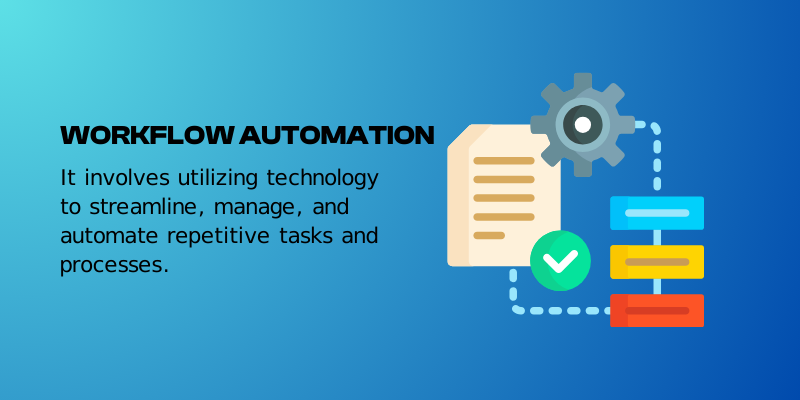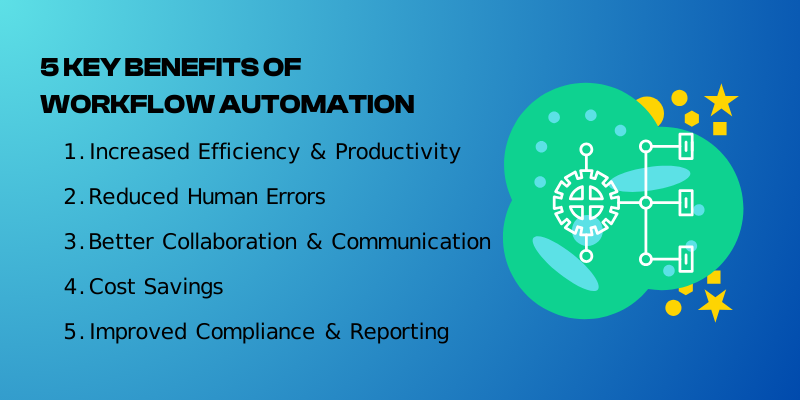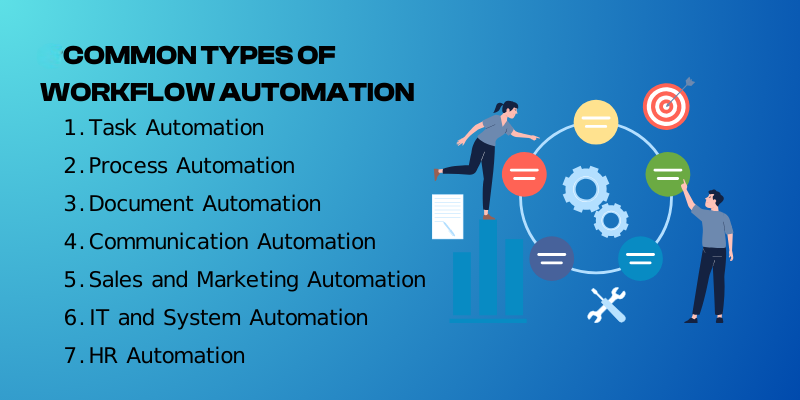Are you wondering what is workflow automation and how it can transform your business and boost efficiency?
It’s the process of automating repetitive tasks and processes within a business to improve efficiency and reduce human error.
Workflow automation utilizes technology to streamline operations, allowing businesses to automate manual and time-consuming tasks such as data entry, report generation, and approval processes.
By doing so, organizations can free up valuable time for employees to focus on more strategic and creative work.
The key to workflow automation is the integration of software tools and applications that work together to perform tasks without manual intervention.
Whether it's automating customer service requests, managing inventory, or processing invoices, workflow automation helps businesses save time, increase productivity, and enhance decision-making.
Moreover, by implementing automated workflows, businesses can improve accuracy, ensure compliance, and provide faster service to customers.
This blog covers everything you need to know about workflow automation, from its various types and key benefits to how to implement it and the future it promises.
What is Workflow Automation?
Workflow automation involves using technology to streamline, manage, and execute repetitive tasks and processes automatically, without constant manual intervention.

This is achieved by setting predefined rules, conditions, and triggers, which enable the system to carry out subsequent actions once a specific event occurs.
For instance, in a manual process, when an employee receives a customer inquiry, they might forward it to the sales team and then update a spreadsheet with the customer's details.
In a workflow automation system, these steps can happen automatically.
The inquiry is routed to the appropriate team, an acknowledgment email is sent to the customer, and the database is updated instantly.
5 Key Benefits of Workflow Automation
Workflow automation is a game-changing tool that streamlines and automates repetitive tasks, processes, and actions within an organization, helping address challenges such as what are five marketing strategies that retailers spend half of their annual budget on? by optimizing resources and driving efficiency.

Here are the most significant benefits
1. Increased Efficiency and Productivity
Workflow automation handles repetitive and time-consuming tasks, freeing up employees to focus on strategic, creative, and high-value activities. This leads to faster task completion, streamlined processes, and improved overall productivity across the organization.
2. Reduced Human Errors
Automation minimizes the risk of mistakes by following predefined rules and processes consistently. This results in more accurate data handling, smoother operations, and fewer disruptions caused by manual errors.
3. Better Collaboration and Communication
Automated workflows ensure all stakeholders stay informed through real-time updates and notifications. This improves team coordination, reduces miscommunication, and keeps projects moving forward seamlessly.
4. Cost Savings
By reducing manual labor and optimizing resource usage, workflow automation lowers operational costs. It allows businesses to achieve more with fewer resources, leading to long-term financial savings.
5. Improved Compliance and Reporting
Workflow automation helps businesses stay compliant with regulations by maintaining accurate records and enforcing policies consistently. It also simplifies reporting, making it easier to track performance and meet regulatory requirements.
Explore Our Web Design & Development Services!
7 Types of Workflow Automation
There are various types of workflow automation designed to streamline different business processes.

Here’s an overview of the most common types:
1. Task Automation
This type involves automating individual tasks or actions within a process, such as sending emails, updating records in a database, or generating reports. Task automation eliminates manual effort for simple, repetitive actions.
2. Process Automation
Process automation automates entire workflows or business processes, often involving multiple tasks and departments. It ensures that processes like order fulfillment or approval workflows happen seamlessly from start to finish.
3. Document Automation
Document automation streamlines the creation, processing, and management of documents,, which is particularly beneficial for agencies offering web design and development services that require extensive documentation for client projects.
It can be used for contracts, invoices, reports, and other business documents, reducing the need for manual handling and approvals.
4. Communication Automation
This type focuses on automating communication tasks, including emails, chatbots, and notifications. Communication automation ensures consistent and timely interactions with customers, employees, and partners.
5. Sales and Marketing Automation
Sales and marketing automation helps businesses run campaigns, nurture leads, and track customer interactions automatically, , similar to what is the digital marketing strategy that tracks users across the web? used to analyze user behavior and improve targeting
This type of automation helps increase conversions and improve customer engagement.
6. IT and System Automation
IT and system automation involves automating routine IT tasks such as system monitoring, software updates, and data backups. It ensures that IT operations run smoothly without manual intervention.
7. HR Automation
HR automation simplifies tasks like recruitment, onboarding, leave management, and payroll. It improves HR efficiency, reduces errors, and ensures compliance with policies and regulations.
Examples of Workflow Automation
Workflow automation can be applied across various teams to streamline processes and boost productivity.
Here are some key examples of how different roles use automation:
-
Product Managers
Product managers can significantly benefit from workflow automation in decision-making and product development.
Automated product feedback collection allows managers to gather user insights from multiple channels and categorize them by sentiment and feature areas, much like using a simple tool for how to search a word on a website to quickly locate critical data within vast feedback reports. This automation provides actionable insights, enabling better product improvements.
Additionally, automating feature request prioritization helps product managers assess requests based on predefined criteria such as potential impact, development effort, and alignment with product strategy.
-
Engineering Leads
For engineering leads, workflow automation is essential in improving code quality and streamlining the development cycle.
Automated code reviews ensure that team members with the relevant expertise and availability are assigned to review code, with reminders set for pending reviews. This speeds up the review process and ensures high-quality code.
Continuous integration and deployment (CI/CD) pipelines further streamline development by automating the testing and deployment process, reducing manual errors and accelerating the release cycle.
-
Project Managers
Project managers can leverage workflow automation to improve project visibility and resource management.
Automating project status reporting allows for easy collection of progress updates from team members, which are then compiled into standardized reports and shared with stakeholders, similar to how marketers track Google keyword ranking reports to measure SEO performance. This ensures transparency and keeps everyone aligned.
Resource allocation automation optimizes team performance by tracking workloads and suggesting task reassignments to balance resources and meet deadlines.
-
Marketing Teams
Marketing teams can greatly enhance their efficiency and execution by automating campaign workflows, which can include managing advertisement examples and campaign assets to ensure consistent branding and messaging
For example, automating the creation of design and copywriting tickets in Jira ensures that all tasks related to email marketing campaigns are linked and managed efficiently. This keeps everyone on track and ensures timely execution.
Content management is another area where automation excels, especially when paired with the best website builders for small business to streamline content publishing and site updates.
Workflow automation can automatically assign content tasks based on team members' availability and workloads, ensuring that the content creation process moves smoothly through its pipeline.
Workflow automation simplifies operations, reduces manual effort, and boosts efficiency across various roles and departments.
Explore Our Digital Marketing Services!
How to Implement Workflow Automation?
Follow this clear, step-by-step guide to implement workflow automation effectively:
1. Identify Repetitive Tasks
Audit daily tasks to identify high-volume, rule-based processes that consume time or cause delays, , such as integrating lead generation tools to streamline the process of capturing and nurturing prospects.
Prioritize based on time spent, error rates, and business impact. Start by automating a quick win to see immediate results.
2. Set Clear Goals
Define specific outcomes and key performance indicators (KPIs) like cycle time, error rates, and SLA adherence. Assign ownership, establish timelines, and address constraints such as privacy, security, and compliance requirements.
3. Choose the Right Tool
Select a tool that fits your needs by considering required features, integrations, user roles, data residency, no-code/low-code options, budget, and available support, similar to how companies evaluate the best SEO reporting software for tracking search performance and optimizing campaigns."
Shortlist two or three tools and run a proof of concept to evaluate their fit.
4. Map the Workflow
Create diagrams for the current ("as-is") and target ("to-be") workflows. Clearly define triggers, rules, actions, data fields, approval processes, exception paths, notifications, permissions, and audit logs.
5. Test and Optimize
Test the automation in a sandbox with real-world scenarios and edge cases. Pilot the system with a small group, collect feedback, and monitor KPIs. Address any gaps, document the process, provide training, and scale gradually.
By following these steps, you can implement workflow automation smoothly, optimizing efficiency and improving performance over time.
4 Best Practices for Implementing Workflow Automation
To maximize the benefits of workflow automation, follow these best practices:
- Start small and scale gradually: Begin by automating a simple process and set clear goals. As you gain experience and see positive results, expand automation to more complex workflows.
- Involve key stakeholders: Engage team members who will be using the automated workflows. Their feedback helps design effective systems and ensures better adoption across the organization.
- Monitor and optimize continuously: Regularly evaluate the performance of automated workflows. Track key metrics like time saved and user satisfaction, and make adjustments to refine your processes.
- Maintain a balance between automation and human oversight: Design workflows with checkpoints for human review, especially for critical decisions. This ensures that automation supports, rather than replaces, human judgment.
By following these practices, you can implement workflow automation in a way that enhances productivity and fosters continuous improvement.
Future of Workflow Automation
The future of workflow automation is being shaped by rapid technological advancements that are revolutionizing business operations.
At the forefront of this transformation is AI-driven automation, which enables systems to learn, predict, and make decisions with minimal human intervention.
This evolution allows workflows to handle increasingly complex tasks, such as data analysis, predictive maintenance, and personalized customer interactions, with unmatched accuracy and speed.
Another significant trend is the rise of low-code and no-code platforms, which democratize workflow automation by making it accessible to non-technical users, much like top search engines make information accessible for businesses to analyze and leverage.
These platforms allow teams to design, deploy, and manage automated processes through intuitive drag-and-drop interfaces, reducing the need for developer involvement and accelerating the digital transformation journey.
Additionally, hyperautomation is emerging as a powerful approach to business process automation. By combining AI, machine learning, robotic process automation (RPA), and advanced analytics, hyperautomation enables businesses to automate end-to-end processes, from start to finish, providing powerful solutions for b2b marketing and enterprise-level operations.
As these trends continue to evolve, workflow automation will become more intelligent, scalable, and adaptable, empowering businesses like Centric to work faster, reduce costs, and remain competitive in an increasingly digital and dynamic world.
Book Your Free Expert Consultation!
Final Thoughts
Having explored what is workflow automation and how it transforms business operations, it's clear that it has become an essential tool for modern organizations.
By automating repetitive manual tasks, workflow automation allows teams to save valuable time and resources, making it a vital strategy for any tech marketing agency seeking to improve accuracy, consistency, and efficiency.
With streamlined workflows, businesses can shift their focus from routine tasks to innovation, strategy, and growth.
As technology advances, workflow automation will only become more powerful and accessible, enabling businesses of all sizes to scale effectively and stay competitive.
Embracing what workflow automation offers today is the key to building a more productive, agile, and future-ready organization.









